Essay on Hormonal Regulation's Role in Clinical Aesthetics
VerifiedAdded on 2022/10/07
|8
|2594
|25
Essay
AI Summary
This essay critically examines the interplay between hormonal regulation and clinical aesthetics, focusing on the field of aesthetic endocrinology and its implications for various physiological conditions. It explores the use of sex steroids and hormone therapies to address issues such as skin aging, hair loss, acne, and body composition changes. The essay delves into the anatomy of the endocrine system and the function of hormones, differentiating them from neurotransmitters. It highlights the role of clinical aesthetics in improving cosmetic appearance through surgical and non-surgical procedures. The study discusses the application of hormone-based treatments like bioidentical-hormone-replacement-therapy (BHRT), hormone-therapy, and hormone-pellet-therapy (HPT) in age prevention and the management of hormonal imbalances in men and women. The essay also covers acne treatment via Hormone Therapy (HT) and Menopausal Hormone Therapy (MHT), providing an overview of their positive and negative impacts. It concludes by emphasizing the futuristic applications of hormonal regulation in clinical aesthetics, highlighting the potential for improving physical, aesthetic, and emotional well-being, and suggesting that hormone regulatory therapies have positive efficacies to human health with little or no reported side-effects.
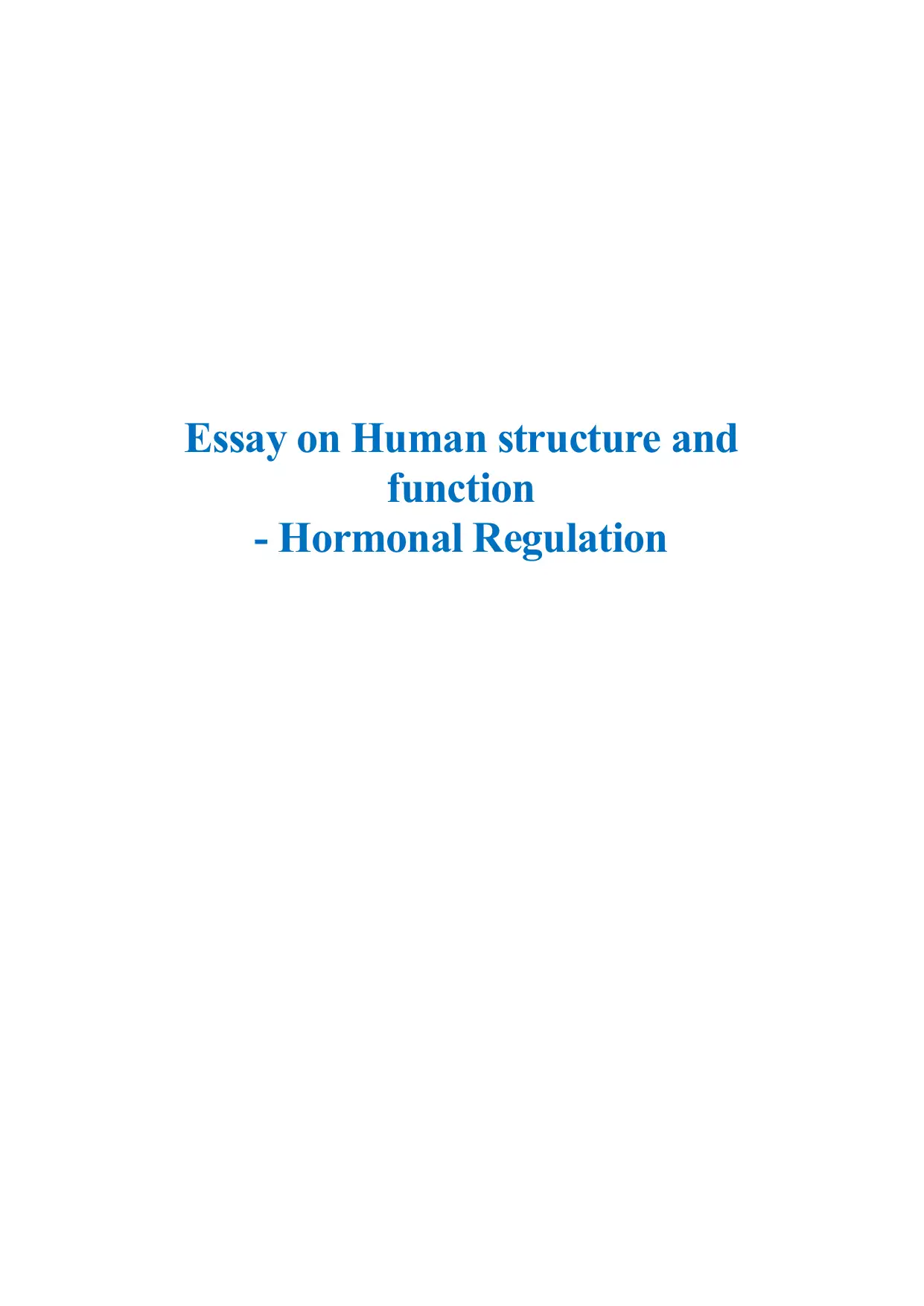
Essay on Human structure and
function
- Hormonal Regulation
function
- Hormonal Regulation
Paraphrase This Document
Need a fresh take? Get an instant paraphrase of this document with our AI Paraphraser
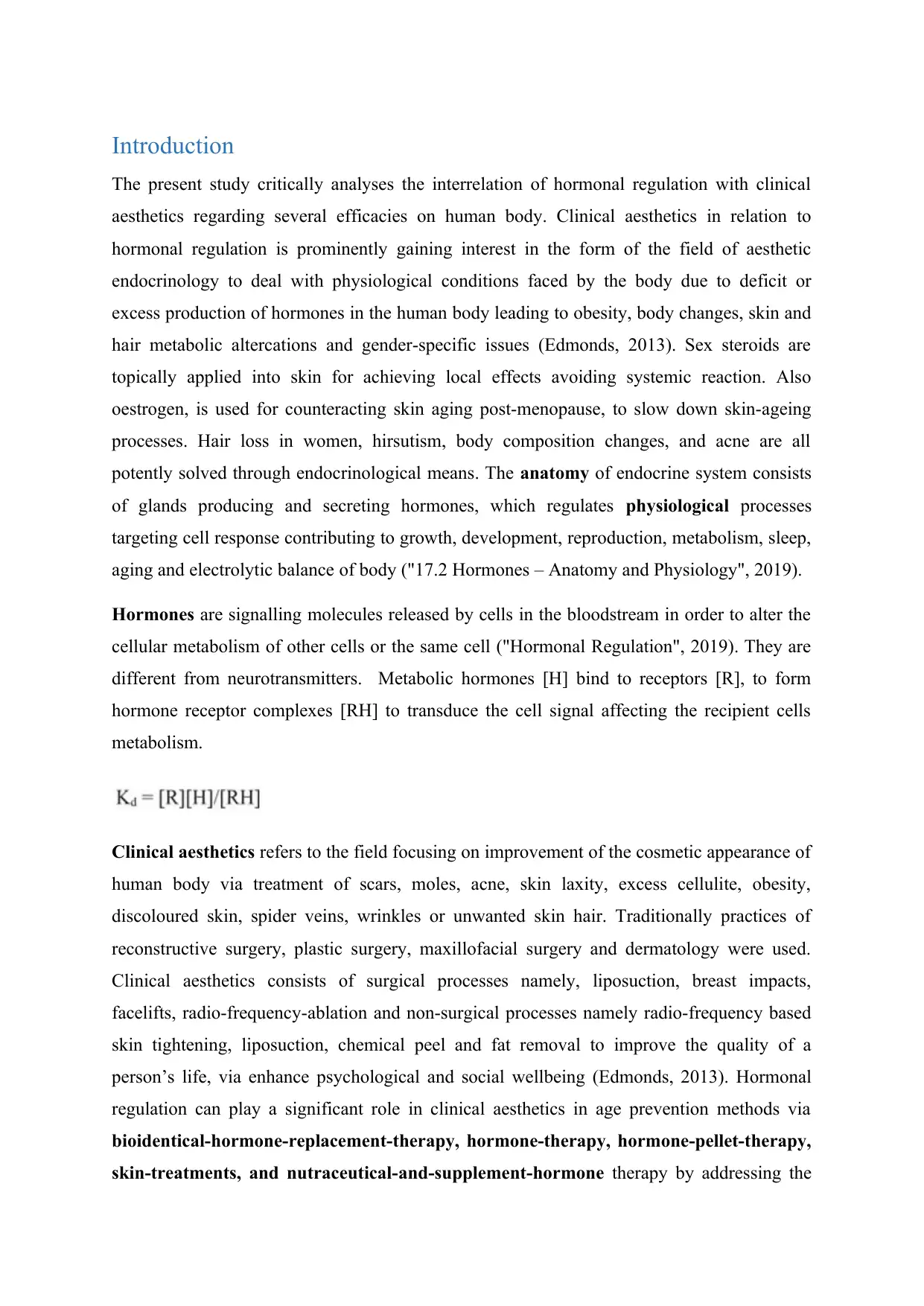
Introduction
The present study critically analyses the interrelation of hormonal regulation with clinical
aesthetics regarding several efficacies on human body. Clinical aesthetics in relation to
hormonal regulation is prominently gaining interest in the form of the field of aesthetic
endocrinology to deal with physiological conditions faced by the body due to deficit or
excess production of hormones in the human body leading to obesity, body changes, skin and
hair metabolic altercations and gender-specific issues (Edmonds, 2013). Sex steroids are
topically applied into skin for achieving local effects avoiding systemic reaction. Also
oestrogen, is used for counteracting skin aging post-menopause, to slow down skin-ageing
processes. Hair loss in women, hirsutism, body composition changes, and acne are all
potently solved through endocrinological means. The anatomy of endocrine system consists
of glands producing and secreting hormones, which regulates physiological processes
targeting cell response contributing to growth, development, reproduction, metabolism, sleep,
aging and electrolytic balance of body ("17.2 Hormones – Anatomy and Physiology", 2019).
Hormones are signalling molecules released by cells in the bloodstream in order to alter the
cellular metabolism of other cells or the same cell ("Hormonal Regulation", 2019). They are
different from neurotransmitters. Metabolic hormones [H] bind to receptors [R], to form
hormone receptor complexes [RH] to transduce the cell signal affecting the recipient cells
metabolism.
Clinical aesthetics refers to the field focusing on improvement of the cosmetic appearance of
human body via treatment of scars, moles, acne, skin laxity, excess cellulite, obesity,
discoloured skin, spider veins, wrinkles or unwanted skin hair. Traditionally practices of
reconstructive surgery, plastic surgery, maxillofacial surgery and dermatology were used.
Clinical aesthetics consists of surgical processes namely, liposuction, breast impacts,
facelifts, radio-frequency-ablation and non-surgical processes namely radio-frequency based
skin tightening, liposuction, chemical peel and fat removal to improve the quality of a
person’s life, via enhance psychological and social wellbeing (Edmonds, 2013). Hormonal
regulation can play a significant role in clinical aesthetics in age prevention methods via
bioidentical-hormone-replacement-therapy, hormone-therapy, hormone-pellet-therapy,
skin-treatments, and nutraceutical-and-supplement-hormone therapy by addressing the
The present study critically analyses the interrelation of hormonal regulation with clinical
aesthetics regarding several efficacies on human body. Clinical aesthetics in relation to
hormonal regulation is prominently gaining interest in the form of the field of aesthetic
endocrinology to deal with physiological conditions faced by the body due to deficit or
excess production of hormones in the human body leading to obesity, body changes, skin and
hair metabolic altercations and gender-specific issues (Edmonds, 2013). Sex steroids are
topically applied into skin for achieving local effects avoiding systemic reaction. Also
oestrogen, is used for counteracting skin aging post-menopause, to slow down skin-ageing
processes. Hair loss in women, hirsutism, body composition changes, and acne are all
potently solved through endocrinological means. The anatomy of endocrine system consists
of glands producing and secreting hormones, which regulates physiological processes
targeting cell response contributing to growth, development, reproduction, metabolism, sleep,
aging and electrolytic balance of body ("17.2 Hormones – Anatomy and Physiology", 2019).
Hormones are signalling molecules released by cells in the bloodstream in order to alter the
cellular metabolism of other cells or the same cell ("Hormonal Regulation", 2019). They are
different from neurotransmitters. Metabolic hormones [H] bind to receptors [R], to form
hormone receptor complexes [RH] to transduce the cell signal affecting the recipient cells
metabolism.
Clinical aesthetics refers to the field focusing on improvement of the cosmetic appearance of
human body via treatment of scars, moles, acne, skin laxity, excess cellulite, obesity,
discoloured skin, spider veins, wrinkles or unwanted skin hair. Traditionally practices of
reconstructive surgery, plastic surgery, maxillofacial surgery and dermatology were used.
Clinical aesthetics consists of surgical processes namely, liposuction, breast impacts,
facelifts, radio-frequency-ablation and non-surgical processes namely radio-frequency based
skin tightening, liposuction, chemical peel and fat removal to improve the quality of a
person’s life, via enhance psychological and social wellbeing (Edmonds, 2013). Hormonal
regulation can play a significant role in clinical aesthetics in age prevention methods via
bioidentical-hormone-replacement-therapy, hormone-therapy, hormone-pellet-therapy,
skin-treatments, and nutraceutical-and-supplement-hormone therapy by addressing the
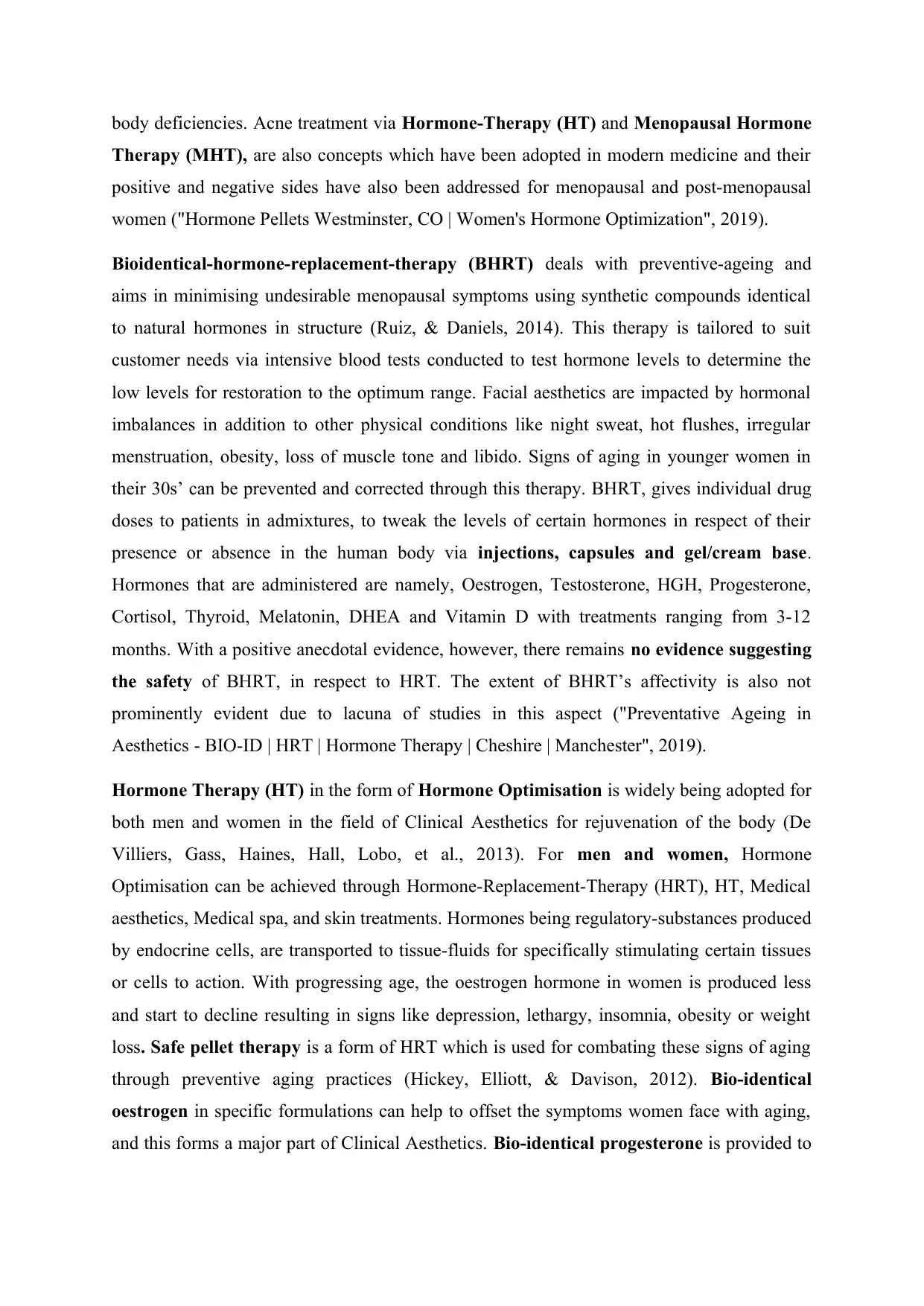
body deficiencies. Acne treatment via Hormone-Therapy (HT) and Menopausal Hormone
Therapy (MHT), are also concepts which have been adopted in modern medicine and their
positive and negative sides have also been addressed for menopausal and post-menopausal
women ("Hormone Pellets Westminster, CO | Women's Hormone Optimization", 2019).
Bioidentical-hormone-replacement-therapy (BHRT) deals with preventive-ageing and
aims in minimising undesirable menopausal symptoms using synthetic compounds identical
to natural hormones in structure (Ruiz, & Daniels, 2014). This therapy is tailored to suit
customer needs via intensive blood tests conducted to test hormone levels to determine the
low levels for restoration to the optimum range. Facial aesthetics are impacted by hormonal
imbalances in addition to other physical conditions like night sweat, hot flushes, irregular
menstruation, obesity, loss of muscle tone and libido. Signs of aging in younger women in
their 30s’ can be prevented and corrected through this therapy. BHRT, gives individual drug
doses to patients in admixtures, to tweak the levels of certain hormones in respect of their
presence or absence in the human body via injections, capsules and gel/cream base.
Hormones that are administered are namely, Oestrogen, Testosterone, HGH, Progesterone,
Cortisol, Thyroid, Melatonin, DHEA and Vitamin D with treatments ranging from 3-12
months. With a positive anecdotal evidence, however, there remains no evidence suggesting
the safety of BHRT, in respect to HRT. The extent of BHRT’s affectivity is also not
prominently evident due to lacuna of studies in this aspect ("Preventative Ageing in
Aesthetics - BIO-ID | HRT | Hormone Therapy | Cheshire | Manchester", 2019).
Hormone Therapy (HT) in the form of Hormone Optimisation is widely being adopted for
both men and women in the field of Clinical Aesthetics for rejuvenation of the body (De
Villiers, Gass, Haines, Hall, Lobo, et al., 2013). For men and women, Hormone
Optimisation can be achieved through Hormone-Replacement-Therapy (HRT), HT, Medical
aesthetics, Medical spa, and skin treatments. Hormones being regulatory-substances produced
by endocrine cells, are transported to tissue-fluids for specifically stimulating certain tissues
or cells to action. With progressing age, the oestrogen hormone in women is produced less
and start to decline resulting in signs like depression, lethargy, insomnia, obesity or weight
loss. Safe pellet therapy is a form of HRT which is used for combating these signs of aging
through preventive aging practices (Hickey, Elliott, & Davison, 2012). Bio-identical
oestrogen in specific formulations can help to offset the symptoms women face with aging,
and this forms a major part of Clinical Aesthetics. Bio-identical progesterone is provided to
Therapy (MHT), are also concepts which have been adopted in modern medicine and their
positive and negative sides have also been addressed for menopausal and post-menopausal
women ("Hormone Pellets Westminster, CO | Women's Hormone Optimization", 2019).
Bioidentical-hormone-replacement-therapy (BHRT) deals with preventive-ageing and
aims in minimising undesirable menopausal symptoms using synthetic compounds identical
to natural hormones in structure (Ruiz, & Daniels, 2014). This therapy is tailored to suit
customer needs via intensive blood tests conducted to test hormone levels to determine the
low levels for restoration to the optimum range. Facial aesthetics are impacted by hormonal
imbalances in addition to other physical conditions like night sweat, hot flushes, irregular
menstruation, obesity, loss of muscle tone and libido. Signs of aging in younger women in
their 30s’ can be prevented and corrected through this therapy. BHRT, gives individual drug
doses to patients in admixtures, to tweak the levels of certain hormones in respect of their
presence or absence in the human body via injections, capsules and gel/cream base.
Hormones that are administered are namely, Oestrogen, Testosterone, HGH, Progesterone,
Cortisol, Thyroid, Melatonin, DHEA and Vitamin D with treatments ranging from 3-12
months. With a positive anecdotal evidence, however, there remains no evidence suggesting
the safety of BHRT, in respect to HRT. The extent of BHRT’s affectivity is also not
prominently evident due to lacuna of studies in this aspect ("Preventative Ageing in
Aesthetics - BIO-ID | HRT | Hormone Therapy | Cheshire | Manchester", 2019).
Hormone Therapy (HT) in the form of Hormone Optimisation is widely being adopted for
both men and women in the field of Clinical Aesthetics for rejuvenation of the body (De
Villiers, Gass, Haines, Hall, Lobo, et al., 2013). For men and women, Hormone
Optimisation can be achieved through Hormone-Replacement-Therapy (HRT), HT, Medical
aesthetics, Medical spa, and skin treatments. Hormones being regulatory-substances produced
by endocrine cells, are transported to tissue-fluids for specifically stimulating certain tissues
or cells to action. With progressing age, the oestrogen hormone in women is produced less
and start to decline resulting in signs like depression, lethargy, insomnia, obesity or weight
loss. Safe pellet therapy is a form of HRT which is used for combating these signs of aging
through preventive aging practices (Hickey, Elliott, & Davison, 2012). Bio-identical
oestrogen in specific formulations can help to offset the symptoms women face with aging,
and this forms a major part of Clinical Aesthetics. Bio-identical progesterone is provided to
⊘ This is a preview!⊘
Do you want full access?
Subscribe today to unlock all pages.

Trusted by 1+ million students worldwide
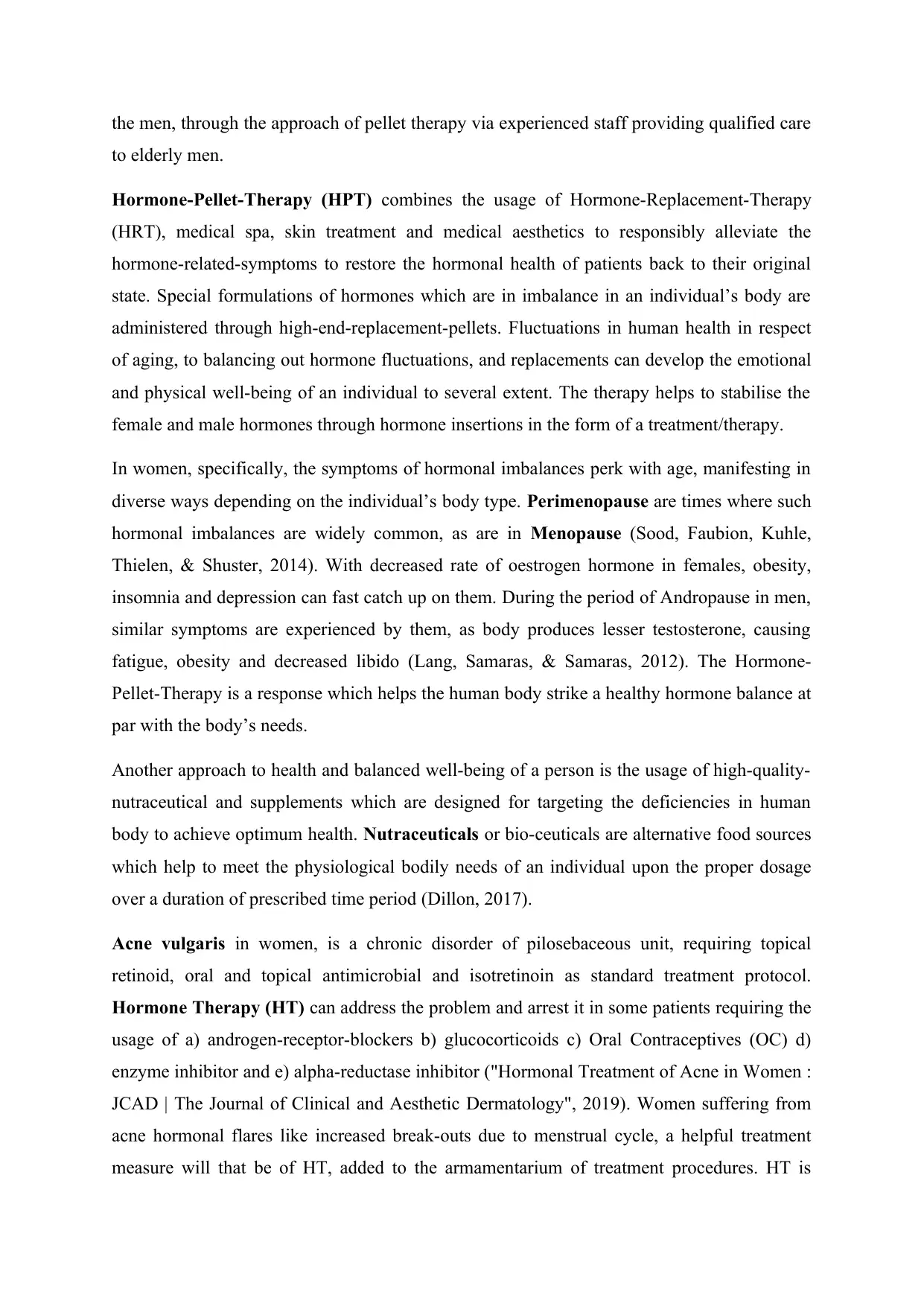
the men, through the approach of pellet therapy via experienced staff providing qualified care
to elderly men.
Hormone-Pellet-Therapy (HPT) combines the usage of Hormone-Replacement-Therapy
(HRT), medical spa, skin treatment and medical aesthetics to responsibly alleviate the
hormone-related-symptoms to restore the hormonal health of patients back to their original
state. Special formulations of hormones which are in imbalance in an individual’s body are
administered through high-end-replacement-pellets. Fluctuations in human health in respect
of aging, to balancing out hormone fluctuations, and replacements can develop the emotional
and physical well-being of an individual to several extent. The therapy helps to stabilise the
female and male hormones through hormone insertions in the form of a treatment/therapy.
In women, specifically, the symptoms of hormonal imbalances perk with age, manifesting in
diverse ways depending on the individual’s body type. Perimenopause are times where such
hormonal imbalances are widely common, as are in Menopause (Sood, Faubion, Kuhle,
Thielen, & Shuster, 2014). With decreased rate of oestrogen hormone in females, obesity,
insomnia and depression can fast catch up on them. During the period of Andropause in men,
similar symptoms are experienced by them, as body produces lesser testosterone, causing
fatigue, obesity and decreased libido (Lang, Samaras, & Samaras, 2012). The Hormone-
Pellet-Therapy is a response which helps the human body strike a healthy hormone balance at
par with the body’s needs.
Another approach to health and balanced well-being of a person is the usage of high-quality-
nutraceutical and supplements which are designed for targeting the deficiencies in human
body to achieve optimum health. Nutraceuticals or bio-ceuticals are alternative food sources
which help to meet the physiological bodily needs of an individual upon the proper dosage
over a duration of prescribed time period (Dillon, 2017).
Acne vulgaris in women, is a chronic disorder of pilosebaceous unit, requiring topical
retinoid, oral and topical antimicrobial and isotretinoin as standard treatment protocol.
Hormone Therapy (HT) can address the problem and arrest it in some patients requiring the
usage of a) androgen-receptor-blockers b) glucocorticoids c) Oral Contraceptives (OC) d)
enzyme inhibitor and e) alpha-reductase inhibitor ("Hormonal Treatment of Acne in Women :
JCAD | The Journal of Clinical and Aesthetic Dermatology", 2019). Women suffering from
acne hormonal flares like increased break-outs due to menstrual cycle, a helpful treatment
measure will that be of HT, added to the armamentarium of treatment procedures. HT is
to elderly men.
Hormone-Pellet-Therapy (HPT) combines the usage of Hormone-Replacement-Therapy
(HRT), medical spa, skin treatment and medical aesthetics to responsibly alleviate the
hormone-related-symptoms to restore the hormonal health of patients back to their original
state. Special formulations of hormones which are in imbalance in an individual’s body are
administered through high-end-replacement-pellets. Fluctuations in human health in respect
of aging, to balancing out hormone fluctuations, and replacements can develop the emotional
and physical well-being of an individual to several extent. The therapy helps to stabilise the
female and male hormones through hormone insertions in the form of a treatment/therapy.
In women, specifically, the symptoms of hormonal imbalances perk with age, manifesting in
diverse ways depending on the individual’s body type. Perimenopause are times where such
hormonal imbalances are widely common, as are in Menopause (Sood, Faubion, Kuhle,
Thielen, & Shuster, 2014). With decreased rate of oestrogen hormone in females, obesity,
insomnia and depression can fast catch up on them. During the period of Andropause in men,
similar symptoms are experienced by them, as body produces lesser testosterone, causing
fatigue, obesity and decreased libido (Lang, Samaras, & Samaras, 2012). The Hormone-
Pellet-Therapy is a response which helps the human body strike a healthy hormone balance at
par with the body’s needs.
Another approach to health and balanced well-being of a person is the usage of high-quality-
nutraceutical and supplements which are designed for targeting the deficiencies in human
body to achieve optimum health. Nutraceuticals or bio-ceuticals are alternative food sources
which help to meet the physiological bodily needs of an individual upon the proper dosage
over a duration of prescribed time period (Dillon, 2017).
Acne vulgaris in women, is a chronic disorder of pilosebaceous unit, requiring topical
retinoid, oral and topical antimicrobial and isotretinoin as standard treatment protocol.
Hormone Therapy (HT) can address the problem and arrest it in some patients requiring the
usage of a) androgen-receptor-blockers b) glucocorticoids c) Oral Contraceptives (OC) d)
enzyme inhibitor and e) alpha-reductase inhibitor ("Hormonal Treatment of Acne in Women :
JCAD | The Journal of Clinical and Aesthetic Dermatology", 2019). Women suffering from
acne hormonal flares like increased break-outs due to menstrual cycle, a helpful treatment
measure will that be of HT, added to the armamentarium of treatment procedures. HT is
Paraphrase This Document
Need a fresh take? Get an instant paraphrase of this document with our AI Paraphraser
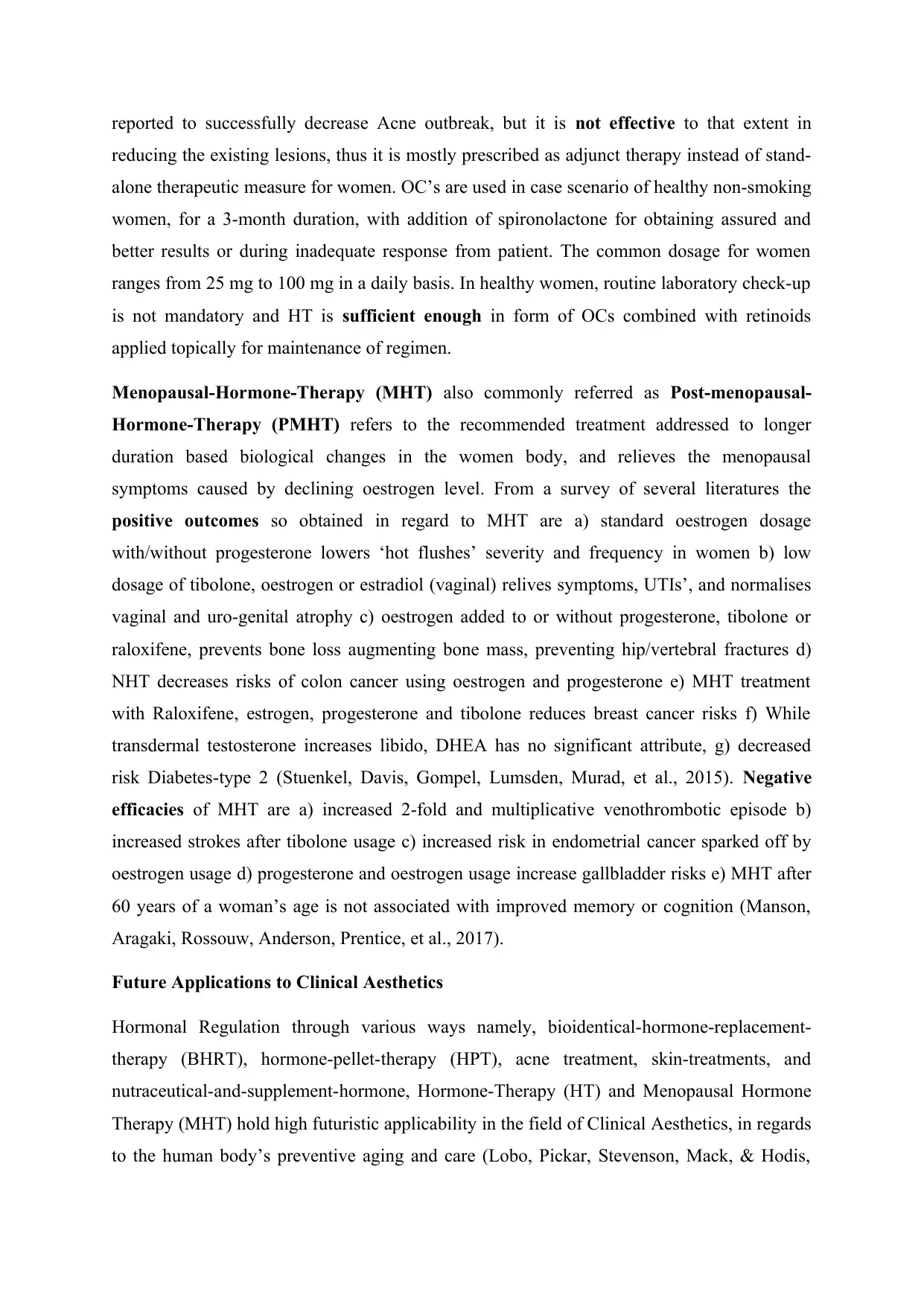
reported to successfully decrease Acne outbreak, but it is not effective to that extent in
reducing the existing lesions, thus it is mostly prescribed as adjunct therapy instead of stand-
alone therapeutic measure for women. OC’s are used in case scenario of healthy non-smoking
women, for a 3-month duration, with addition of spironolactone for obtaining assured and
better results or during inadequate response from patient. The common dosage for women
ranges from 25 mg to 100 mg in a daily basis. In healthy women, routine laboratory check-up
is not mandatory and HT is sufficient enough in form of OCs combined with retinoids
applied topically for maintenance of regimen.
Menopausal-Hormone-Therapy (MHT) also commonly referred as Post-menopausal-
Hormone-Therapy (PMHT) refers to the recommended treatment addressed to longer
duration based biological changes in the women body, and relieves the menopausal
symptoms caused by declining oestrogen level. From a survey of several literatures the
positive outcomes so obtained in regard to MHT are a) standard oestrogen dosage
with/without progesterone lowers ‘hot flushes’ severity and frequency in women b) low
dosage of tibolone, oestrogen or estradiol (vaginal) relives symptoms, UTIs’, and normalises
vaginal and uro-genital atrophy c) oestrogen added to or without progesterone, tibolone or
raloxifene, prevents bone loss augmenting bone mass, preventing hip/vertebral fractures d)
NHT decreases risks of colon cancer using oestrogen and progesterone e) MHT treatment
with Raloxifene, estrogen, progesterone and tibolone reduces breast cancer risks f) While
transdermal testosterone increases libido, DHEA has no significant attribute, g) decreased
risk Diabetes-type 2 (Stuenkel, Davis, Gompel, Lumsden, Murad, et al., 2015). Negative
efficacies of MHT are a) increased 2-fold and multiplicative venothrombotic episode b)
increased strokes after tibolone usage c) increased risk in endometrial cancer sparked off by
oestrogen usage d) progesterone and oestrogen usage increase gallbladder risks e) MHT after
60 years of a woman’s age is not associated with improved memory or cognition (Manson,
Aragaki, Rossouw, Anderson, Prentice, et al., 2017).
Future Applications to Clinical Aesthetics
Hormonal Regulation through various ways namely, bioidentical-hormone-replacement-
therapy (BHRT), hormone-pellet-therapy (HPT), acne treatment, skin-treatments, and
nutraceutical-and-supplement-hormone, Hormone-Therapy (HT) and Menopausal Hormone
Therapy (MHT) hold high futuristic applicability in the field of Clinical Aesthetics, in regards
to the human body’s preventive aging and care (Lobo, Pickar, Stevenson, Mack, & Hodis,
reducing the existing lesions, thus it is mostly prescribed as adjunct therapy instead of stand-
alone therapeutic measure for women. OC’s are used in case scenario of healthy non-smoking
women, for a 3-month duration, with addition of spironolactone for obtaining assured and
better results or during inadequate response from patient. The common dosage for women
ranges from 25 mg to 100 mg in a daily basis. In healthy women, routine laboratory check-up
is not mandatory and HT is sufficient enough in form of OCs combined with retinoids
applied topically for maintenance of regimen.
Menopausal-Hormone-Therapy (MHT) also commonly referred as Post-menopausal-
Hormone-Therapy (PMHT) refers to the recommended treatment addressed to longer
duration based biological changes in the women body, and relieves the menopausal
symptoms caused by declining oestrogen level. From a survey of several literatures the
positive outcomes so obtained in regard to MHT are a) standard oestrogen dosage
with/without progesterone lowers ‘hot flushes’ severity and frequency in women b) low
dosage of tibolone, oestrogen or estradiol (vaginal) relives symptoms, UTIs’, and normalises
vaginal and uro-genital atrophy c) oestrogen added to or without progesterone, tibolone or
raloxifene, prevents bone loss augmenting bone mass, preventing hip/vertebral fractures d)
NHT decreases risks of colon cancer using oestrogen and progesterone e) MHT treatment
with Raloxifene, estrogen, progesterone and tibolone reduces breast cancer risks f) While
transdermal testosterone increases libido, DHEA has no significant attribute, g) decreased
risk Diabetes-type 2 (Stuenkel, Davis, Gompel, Lumsden, Murad, et al., 2015). Negative
efficacies of MHT are a) increased 2-fold and multiplicative venothrombotic episode b)
increased strokes after tibolone usage c) increased risk in endometrial cancer sparked off by
oestrogen usage d) progesterone and oestrogen usage increase gallbladder risks e) MHT after
60 years of a woman’s age is not associated with improved memory or cognition (Manson,
Aragaki, Rossouw, Anderson, Prentice, et al., 2017).
Future Applications to Clinical Aesthetics
Hormonal Regulation through various ways namely, bioidentical-hormone-replacement-
therapy (BHRT), hormone-pellet-therapy (HPT), acne treatment, skin-treatments, and
nutraceutical-and-supplement-hormone, Hormone-Therapy (HT) and Menopausal Hormone
Therapy (MHT) hold high futuristic applicability in the field of Clinical Aesthetics, in regards
to the human body’s preventive aging and care (Lobo, Pickar, Stevenson, Mack, & Hodis,
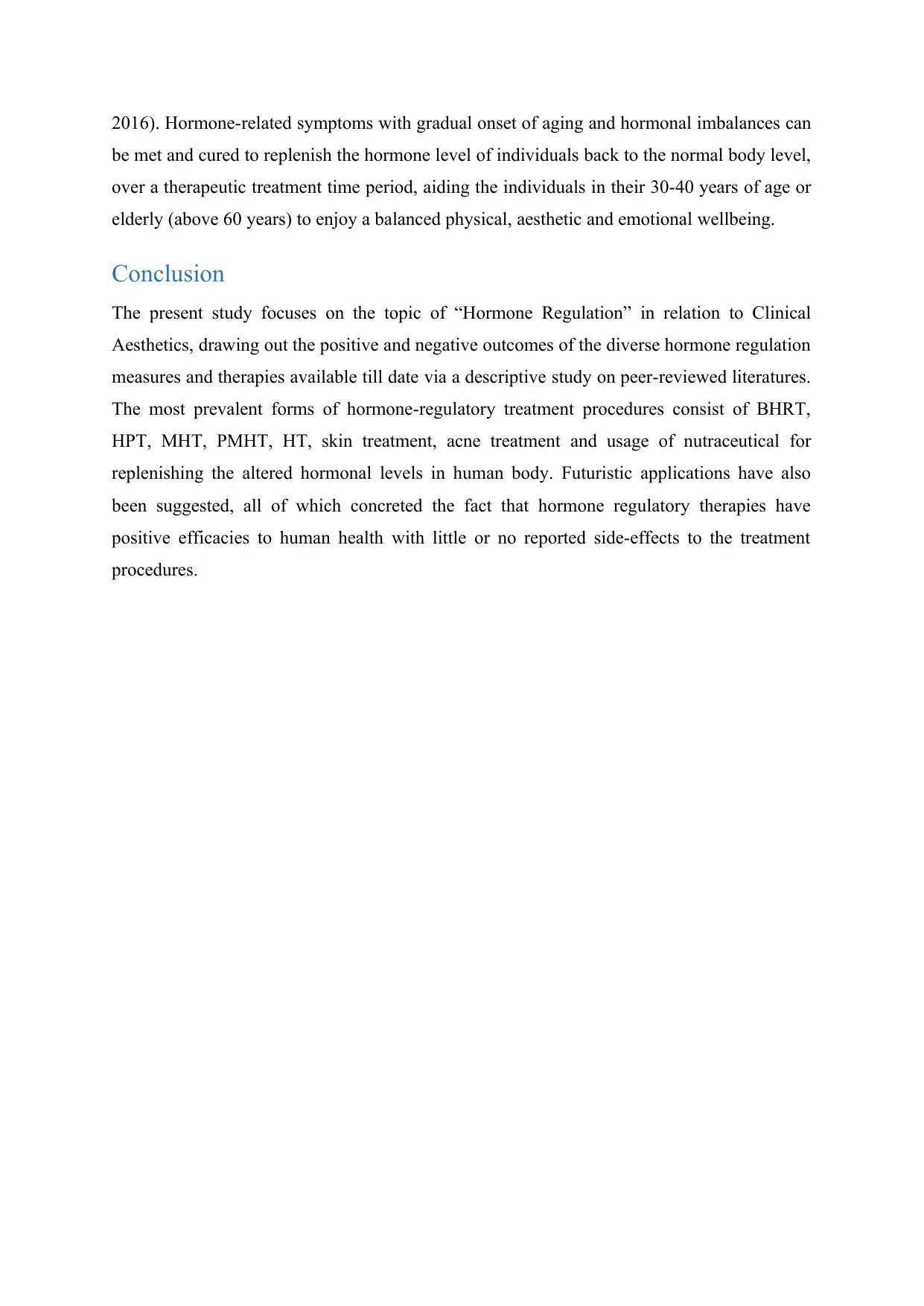
2016). Hormone-related symptoms with gradual onset of aging and hormonal imbalances can
be met and cured to replenish the hormone level of individuals back to the normal body level,
over a therapeutic treatment time period, aiding the individuals in their 30-40 years of age or
elderly (above 60 years) to enjoy a balanced physical, aesthetic and emotional wellbeing.
Conclusion
The present study focuses on the topic of “Hormone Regulation” in relation to Clinical
Aesthetics, drawing out the positive and negative outcomes of the diverse hormone regulation
measures and therapies available till date via a descriptive study on peer-reviewed literatures.
The most prevalent forms of hormone-regulatory treatment procedures consist of BHRT,
HPT, MHT, PMHT, HT, skin treatment, acne treatment and usage of nutraceutical for
replenishing the altered hormonal levels in human body. Futuristic applications have also
been suggested, all of which concreted the fact that hormone regulatory therapies have
positive efficacies to human health with little or no reported side-effects to the treatment
procedures.
be met and cured to replenish the hormone level of individuals back to the normal body level,
over a therapeutic treatment time period, aiding the individuals in their 30-40 years of age or
elderly (above 60 years) to enjoy a balanced physical, aesthetic and emotional wellbeing.
Conclusion
The present study focuses on the topic of “Hormone Regulation” in relation to Clinical
Aesthetics, drawing out the positive and negative outcomes of the diverse hormone regulation
measures and therapies available till date via a descriptive study on peer-reviewed literatures.
The most prevalent forms of hormone-regulatory treatment procedures consist of BHRT,
HPT, MHT, PMHT, HT, skin treatment, acne treatment and usage of nutraceutical for
replenishing the altered hormonal levels in human body. Futuristic applications have also
been suggested, all of which concreted the fact that hormone regulatory therapies have
positive efficacies to human health with little or no reported side-effects to the treatment
procedures.
⊘ This is a preview!⊘
Do you want full access?
Subscribe today to unlock all pages.

Trusted by 1+ million students worldwide
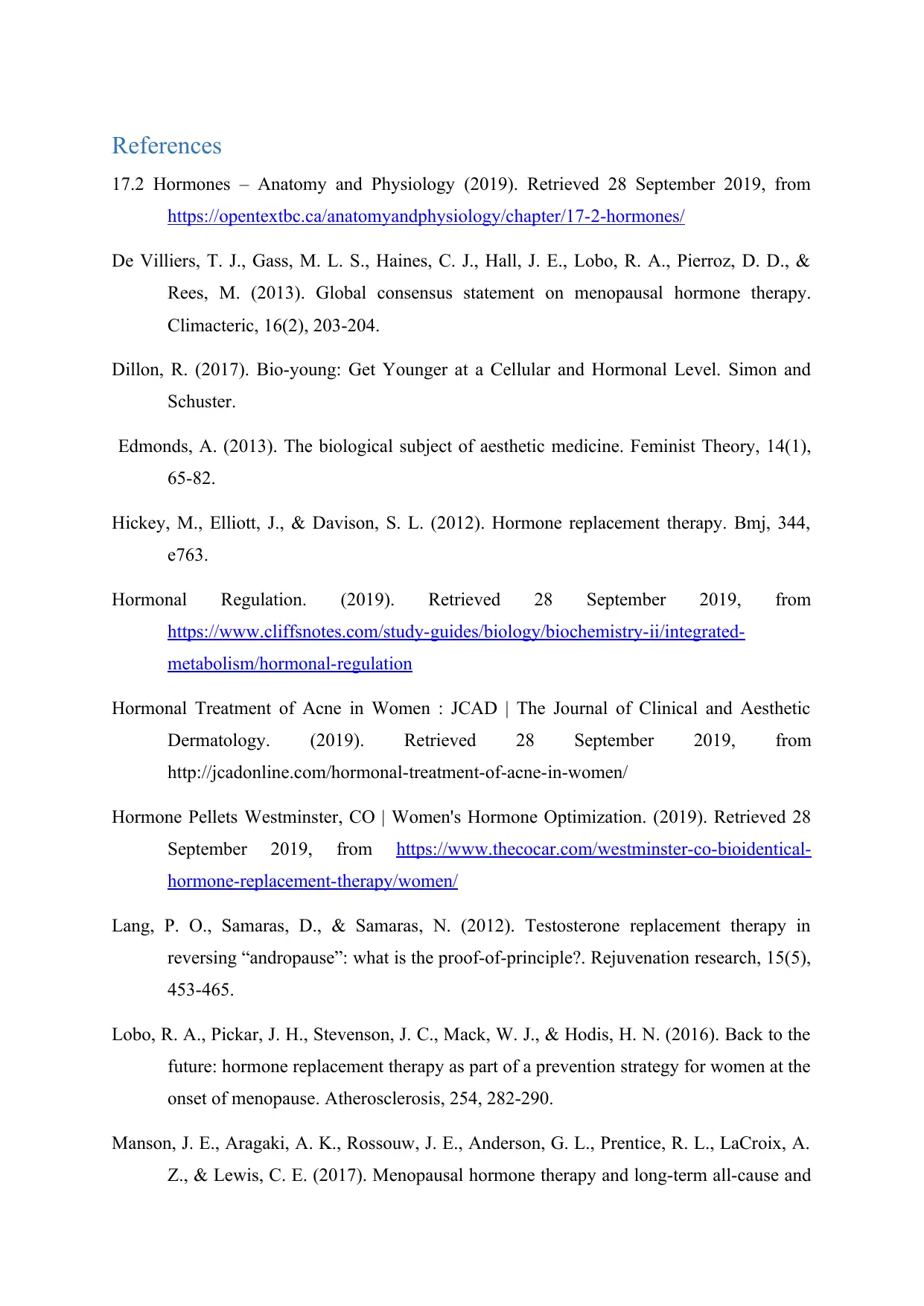
References
17.2 Hormones – Anatomy and Physiology (2019). Retrieved 28 September 2019, from
https://opentextbc.ca/anatomyandphysiology/chapter/17-2-hormones/
De Villiers, T. J., Gass, M. L. S., Haines, C. J., Hall, J. E., Lobo, R. A., Pierroz, D. D., &
Rees, M. (2013). Global consensus statement on menopausal hormone therapy.
Climacteric, 16(2), 203-204.
Dillon, R. (2017). Bio-young: Get Younger at a Cellular and Hormonal Level. Simon and
Schuster.
Edmonds, A. (2013). The biological subject of aesthetic medicine. Feminist Theory, 14(1),
65-82.
Hickey, M., Elliott, J., & Davison, S. L. (2012). Hormone replacement therapy. Bmj, 344,
e763.
Hormonal Regulation. (2019). Retrieved 28 September 2019, from
https://www.cliffsnotes.com/study-guides/biology/biochemistry-ii/integrated-
metabolism/hormonal-regulation
Hormonal Treatment of Acne in Women : JCAD | The Journal of Clinical and Aesthetic
Dermatology. (2019). Retrieved 28 September 2019, from
http://jcadonline.com/hormonal-treatment-of-acne-in-women/
Hormone Pellets Westminster, CO | Women's Hormone Optimization. (2019). Retrieved 28
September 2019, from https://www.thecocar.com/westminster-co-bioidentical-
hormone-replacement-therapy/women/
Lang, P. O., Samaras, D., & Samaras, N. (2012). Testosterone replacement therapy in
reversing “andropause”: what is the proof-of-principle?. Rejuvenation research, 15(5),
453-465.
Lobo, R. A., Pickar, J. H., Stevenson, J. C., Mack, W. J., & Hodis, H. N. (2016). Back to the
future: hormone replacement therapy as part of a prevention strategy for women at the
onset of menopause. Atherosclerosis, 254, 282-290.
Manson, J. E., Aragaki, A. K., Rossouw, J. E., Anderson, G. L., Prentice, R. L., LaCroix, A.
Z., & Lewis, C. E. (2017). Menopausal hormone therapy and long-term all-cause and
17.2 Hormones – Anatomy and Physiology (2019). Retrieved 28 September 2019, from
https://opentextbc.ca/anatomyandphysiology/chapter/17-2-hormones/
De Villiers, T. J., Gass, M. L. S., Haines, C. J., Hall, J. E., Lobo, R. A., Pierroz, D. D., &
Rees, M. (2013). Global consensus statement on menopausal hormone therapy.
Climacteric, 16(2), 203-204.
Dillon, R. (2017). Bio-young: Get Younger at a Cellular and Hormonal Level. Simon and
Schuster.
Edmonds, A. (2013). The biological subject of aesthetic medicine. Feminist Theory, 14(1),
65-82.
Hickey, M., Elliott, J., & Davison, S. L. (2012). Hormone replacement therapy. Bmj, 344,
e763.
Hormonal Regulation. (2019). Retrieved 28 September 2019, from
https://www.cliffsnotes.com/study-guides/biology/biochemistry-ii/integrated-
metabolism/hormonal-regulation
Hormonal Treatment of Acne in Women : JCAD | The Journal of Clinical and Aesthetic
Dermatology. (2019). Retrieved 28 September 2019, from
http://jcadonline.com/hormonal-treatment-of-acne-in-women/
Hormone Pellets Westminster, CO | Women's Hormone Optimization. (2019). Retrieved 28
September 2019, from https://www.thecocar.com/westminster-co-bioidentical-
hormone-replacement-therapy/women/
Lang, P. O., Samaras, D., & Samaras, N. (2012). Testosterone replacement therapy in
reversing “andropause”: what is the proof-of-principle?. Rejuvenation research, 15(5),
453-465.
Lobo, R. A., Pickar, J. H., Stevenson, J. C., Mack, W. J., & Hodis, H. N. (2016). Back to the
future: hormone replacement therapy as part of a prevention strategy for women at the
onset of menopause. Atherosclerosis, 254, 282-290.
Manson, J. E., Aragaki, A. K., Rossouw, J. E., Anderson, G. L., Prentice, R. L., LaCroix, A.
Z., & Lewis, C. E. (2017). Menopausal hormone therapy and long-term all-cause and
Paraphrase This Document
Need a fresh take? Get an instant paraphrase of this document with our AI Paraphraser
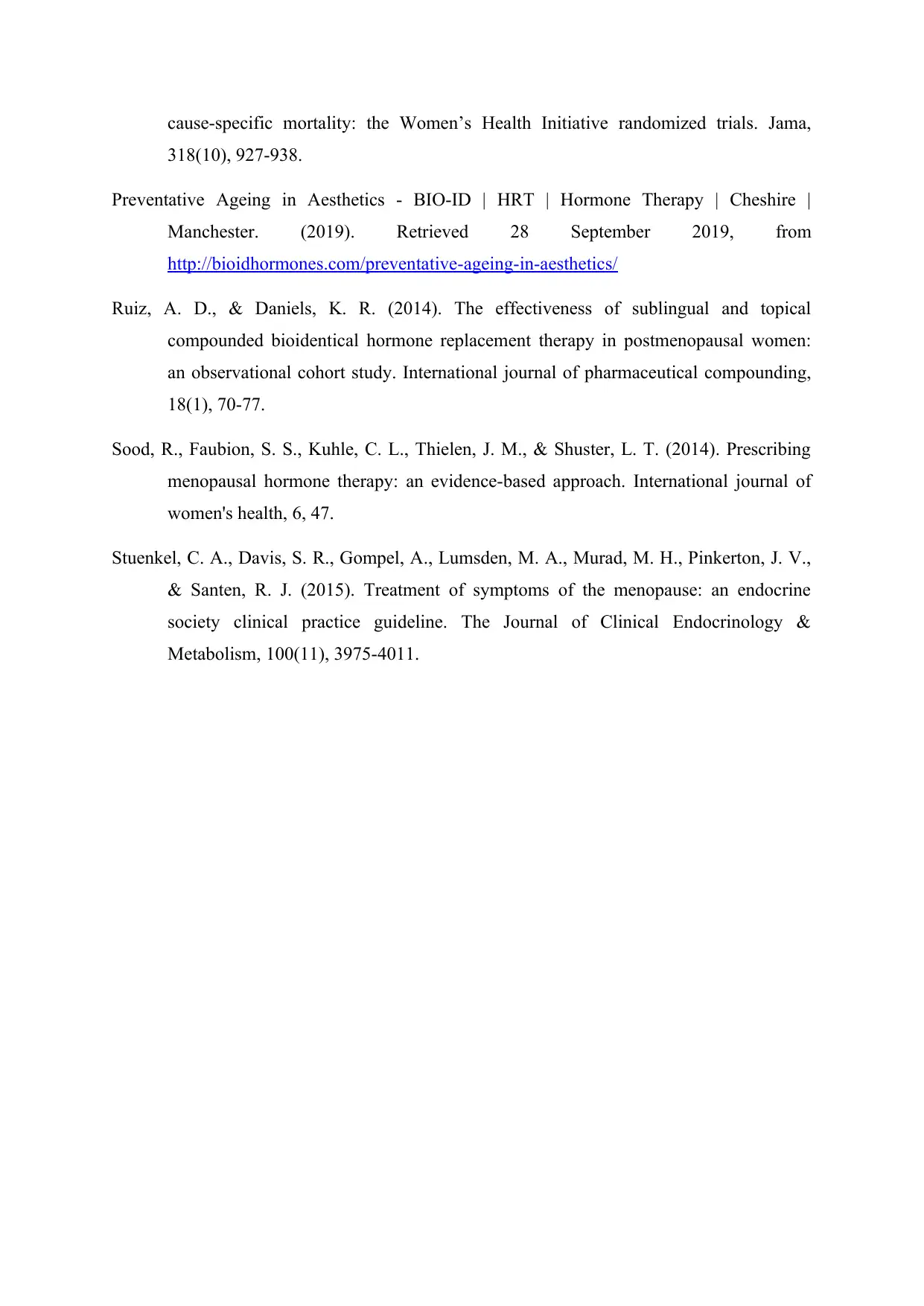
cause-specific mortality: the Women’s Health Initiative randomized trials. Jama,
318(10), 927-938.
Preventative Ageing in Aesthetics - BIO-ID | HRT | Hormone Therapy | Cheshire |
Manchester. (2019). Retrieved 28 September 2019, from
http://bioidhormones.com/preventative-ageing-in-aesthetics/
Ruiz, A. D., & Daniels, K. R. (2014). The effectiveness of sublingual and topical
compounded bioidentical hormone replacement therapy in postmenopausal women:
an observational cohort study. International journal of pharmaceutical compounding,
18(1), 70-77.
Sood, R., Faubion, S. S., Kuhle, C. L., Thielen, J. M., & Shuster, L. T. (2014). Prescribing
menopausal hormone therapy: an evidence-based approach. International journal of
women's health, 6, 47.
Stuenkel, C. A., Davis, S. R., Gompel, A., Lumsden, M. A., Murad, M. H., Pinkerton, J. V.,
& Santen, R. J. (2015). Treatment of symptoms of the menopause: an endocrine
society clinical practice guideline. The Journal of Clinical Endocrinology &
Metabolism, 100(11), 3975-4011.
318(10), 927-938.
Preventative Ageing in Aesthetics - BIO-ID | HRT | Hormone Therapy | Cheshire |
Manchester. (2019). Retrieved 28 September 2019, from
http://bioidhormones.com/preventative-ageing-in-aesthetics/
Ruiz, A. D., & Daniels, K. R. (2014). The effectiveness of sublingual and topical
compounded bioidentical hormone replacement therapy in postmenopausal women:
an observational cohort study. International journal of pharmaceutical compounding,
18(1), 70-77.
Sood, R., Faubion, S. S., Kuhle, C. L., Thielen, J. M., & Shuster, L. T. (2014). Prescribing
menopausal hormone therapy: an evidence-based approach. International journal of
women's health, 6, 47.
Stuenkel, C. A., Davis, S. R., Gompel, A., Lumsden, M. A., Murad, M. H., Pinkerton, J. V.,
& Santen, R. J. (2015). Treatment of symptoms of the menopause: an endocrine
society clinical practice guideline. The Journal of Clinical Endocrinology &
Metabolism, 100(11), 3975-4011.
1 out of 8
Your All-in-One AI-Powered Toolkit for Academic Success.
+13062052269
info@desklib.com
Available 24*7 on WhatsApp / Email
![[object Object]](/_next/static/media/star-bottom.7253800d.svg)
Unlock your academic potential
Copyright © 2020–2025 A2Z Services. All Rights Reserved. Developed and managed by ZUCOL.
